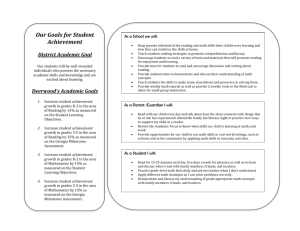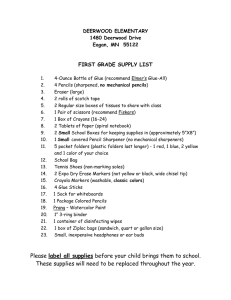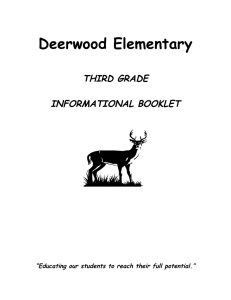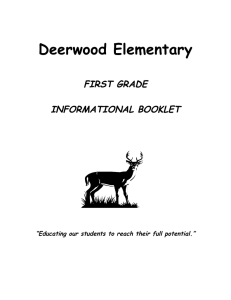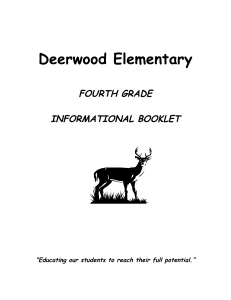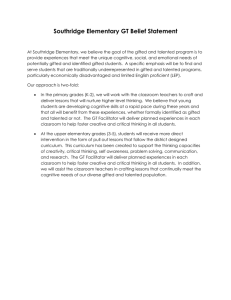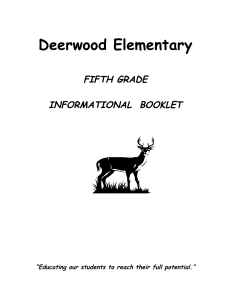Deerwood Elementary SECOND GRADE INFORMATIONAL BOOKLET
advertisement
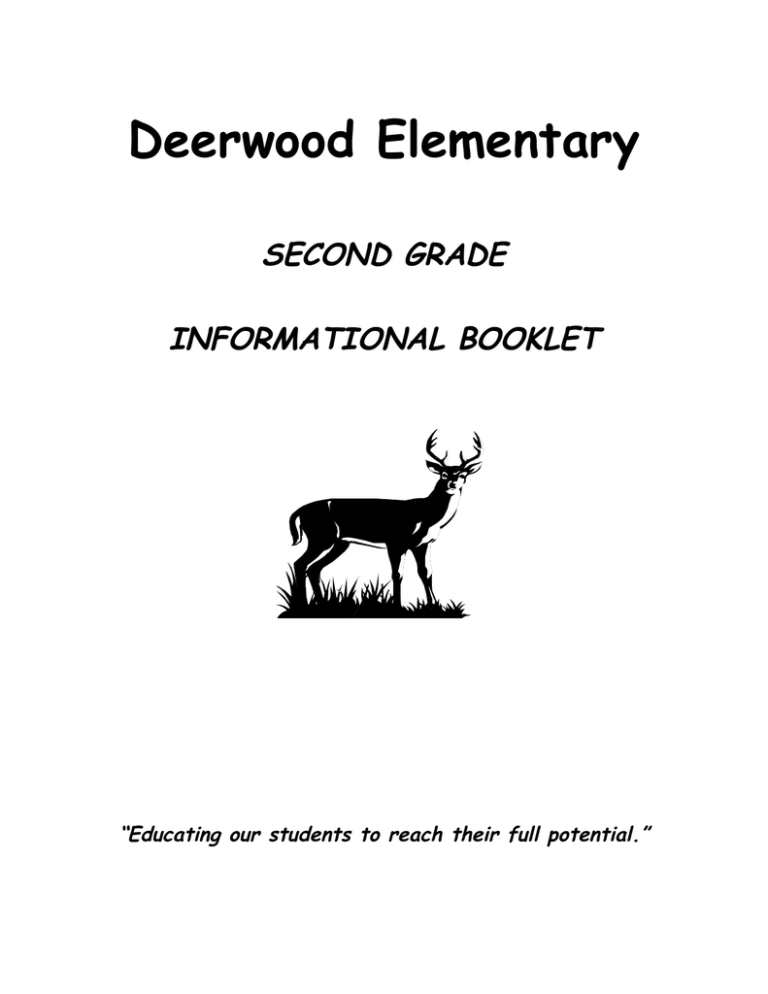
Deerwood Elementary SECOND GRADE INFORMATIONAL BOOKLET “Educating our students to reach their full potential.” Table of Contents Elementary Education Mission Statement and Beliefs………………………. -3- Role of the Parent In Education………………………………………………………………. -4- Second Grade Behavior Plan……………………………………………………………………… -5- Deerwood Elementary School Homework Policy……………………………………. -6- Curriculum……………………………………………………………………………………………………… -8- Special Services…………………………………………………………………………………………… -15- Second Grade Supply List………………………………………………………………………….. -22- 2 Mission Statement Educating our students to reach their full potential. Deerwood’s Beliefs Deerwood is a community of learners, committed to a partnership between students, school, home and community. Our School Community will: • • • • • • • • Promote high standards of academic learning and developmentally appropriate expectations. Develop creative and critical thinking skills needed to solve problems and to communicate effectively and thoughtfully. Strive to develop intellectual curiosity and creative, artistic and aesthetic expression. Develop responsible, self-disciplined individuals with good decision making skills. Develop the interpersonal skills needed to be responsible, compassionate members of society. Promote understanding and respect for diverse cultures, backgrounds, talents, and abilities of others. Nurture the skills necessary in the development of a healthy self-image. Develop our own physical health and well being as well as respect for the physical differences within others. 3 The Role of the Parent in Education Parents play an important role in their child's development and school success at Deerwood. Research has shown that parents of children who are successful in school do two things: They are involved in school programs, and they monitor their child's progress in school. These actions demonstrate to a child that his/her parents are concerned about and value school achievement. Through actions, not just words, parents reinforce the idea that school is important. Be Involved in School Programs It is important to visit your child's classroom and meet his/her teacher. There are several opportunities for you to do this at Deerwood. ♦ An Open House is held before school begins. Feel free to bring school supplies to the Open House. ♦ Parent-teacher conferences are scheduled for November then again for February. ♦ Parents are invited to volunteer in their child's classroom or other areas of the building such as the media center or lunchroom. Monitor Your Child's Progress Parents should monitor their child's progress at school. Check your child's progress by reviewing schoolwork brought home each day and encourage your child to tell about his/her schoolwork and experiences. The extra time and attention you spend will not only build your child's self-esteem, it will also reinforce what your child has learned in school. If you have a concern, please feel free to call or make an appointment with your child's teacher. 4 Home and School Reading and studying will become a natural part of the day for children if parents establish a routine and time for it. Set aside a specific time each day for your child to spend on schoolwork. Your child needs a quiet place for study, free from distractions or interruptions. The length of time spent on reviewing concepts should correlate with your child’s grade level and ability. Research shows that children who are read to, or who read independently, are apt to be better readers, read for enjoyment and develop a life-long love of reading. Therefore, we suggest that a family reading time be part of each day in your home. Please review the papers and projects that your child brings home each day. This will show your child that you believe his/her school work is important and also keep you informed about your child’s work at school. Regular school attendance will help your child develop responsible work habits and emphasize the importance of education. Help your child prepare for school each day. You can do this by making sure your child is rested, has a nutritious breakfast, is properly dressed, has the needed supplies and is carrying a school bag. Together, we have a common goal - to help your child be a happy, well-adjusted learner. Second Grade Behavior Plan The second grade behavior plan is based on our beliefs that it is important for us to create a learning environment in which teaching and learning can take place. We hope to create a positive and caring environment and deal with problems as they occur. We will set consistent, positive limits, while providing warmth and support for the students' appropriate behaviors. We have high expectations for all students to learn how to be safe, responsible individuals who are cooperative and treat others and property with respect. Rules and social skills are taught, modeled and reinforced throughout the year. 5 The following kinds of behavior will be expected from your child in second grade: 1. Respect other's feelings and property 2. Follow directions 3. Take turns talking/Raise hand 4. Keep your hands, feet, and objects to yourself 5. Talk in an appropriate voice Consequences for inappropriate daily behavior: 1st consequence Student's name is recorded 2nd consequence Five minute time-out 3rd consequence Parent notified/Behavior Clerk As a positive reward for appropriate behavior, we may give the students Chance Tickets. The tickets are collected throughout the week and then we will hold a drawing for a student to receive a special reward. The reward may be a material thing such as a sticker, certificate, or a book. It may also be a social reward, such as special time with the teacher, helper for the day, sitting in a special area of the room, etc. If you have any promotional items from your work or items from home that you think the children would enjoy, please send them to school with your child. Your donations will be greatly appreciated. As with all other aspects of your child's education, support from home is essential. Please read and discuss our behavior plan with your child. We look forward to working with you and your child this year. Deerwood Elementary School Homework Policy Homework is not assigned as a daily requirement, but rather as an outgrowth or continuation of a school project. Homework is the child's responsibility--not that of the parent. Being aware of and interested in what your child does at school and in papers and projects he/she brings home is vital to the child's success in school. To help ensure the best possible education for the students at Deerwood Elementary, and to answer questions regarding make-up work, a set of guidelines have been developed. 6 When a student is absent due to family vacations, it is our belief that much more is accomplished during the teaching day other than assigning and correcting of worksheets. Discussions, explorations, discovery through experimentations, social interactions, formal and informal evaluation, and the learning of a new concept in a designed fashion are all missed when the student is not at school. For these reasons, we would like to ask that vacations be planned, whenever possible, during the times when school is not in session. Since that is not always possible, our policy for these occasions is as follows: 1. Homework will not be assigned to students so that it can be completed before they leave on a vacation. 2. Assignments which do not need special lead-up teaching, such as review sheets, drill work, independent work, and journals will be given at the discretion of the teacher. 3. New concepts and ideas which need teacher direction and involvement will not be assigned, but made up upon the return of the student. In the case of student illness, work will be held for the student with ample time to complete work. If the illness is going to be for an extended amount of time, work can be sent home for completion. If a parent wishes to pick up homework for their child, the teacher needs time to put together the assignments. For this reason, we need to be notified in the morning before the start of the school day, or we may not be able to honor the request the same day. Homework may be picked up in the office at the end of the school day, if you have requested it from the teacher. We hope all parents set aside a quiet study time each week night. This practice will become habit and will create a pleasant environment for daily homework now and in the future. A second grader is expected to work on the following out of class: •Spelling list •Practice of basic math facts to 18 (+ and -) •Reading vocabulary and oral reading practice •We recommend 20 minutes of sustained silent reading for those students who are independent readers 7 •Occasional projects for reading and/or social studies •Math homework assignments Second Grade Curriculum Overview Guidance Guidance, which is integrated into other curriculum areas, assists in establishing goals, expectations, support systems and experience for all students. It is designed to enhance student learning by helping students acquire and use lifelong learning skills in three broad areas of development: academic, career and personal/social. The curriculum employs strategies, developmentally appropriate for each level, to enhance academics, provide career awareness, encourage selfawareness, foster interpersonal communication skills and convey life success skills for all students. The guidance and health curricula complement each other to provide knowledge and skills in the area of drug prevention. Resources Variety of district-selected materials Topics Students will acquire knowledge and skills in the following areas: • Improved academic self-concept • Improved learning • Plan to achieve goals • School success • Career awareness • Organization and time management • Self-knowledge • Interpersonal relations • Personal safety 8 Health Development of self-awareness (emotionally, socially and physically) and the best ways of keeping well (healthy decision-making) are emphasized. Topics introduced in the first years are reviewed and discussed in more depth each year along with new topics. The health and guidance curricula complement each other to provide knowledge and skills in the area of drug prevention. Resources Your Health, Harcourt, Inc. Topics Mental/Emotional/Social • Sharing feelings • Conflict resolution • Cooperation • Respect • Differences Chemical Health • Medicine • Illegal drugs • Say NO to drugs Safety and First Aid • Fire safety • Bus safety • Emergencies Nutrition • Food guide pyramid • Reading a food label • Healthy food choices Environmental Health • Protecting the environment • Saving energy and resources • Reduce, reuse, recycle • Pollution Decision-Making • Choosing healthy behaviors (decision-making model) • Reinforcing healthy decisions (refusal skills) 9 Language Arts Reading, writing, listening, speaking, spelling and handwriting are all-important components of language arts. Skills and strategies in each area are modeled, taught and practiced, taking into account the unique needs of each learner. Knowledge and skills are acquired through connected experiences between home, school and community. Students read from a variety of texts, including fiction (short stories and whole books), poetry and nonfiction (textbooks, newspapers and magazines). Students read and write daily. Resources • Classroom Libraries • Guided Reading Resources • Invitations to Literacy, Houghton Mifflin • Writing-Units of Study for Primary Writing • Word Study - Phonics Lessons: Letters, Words and How They Work • Handwriting - District developed Topics Reading • Use graphophonic (sounds), syntactic (language) and semantic (meaning) strategies to understand text • Read and respond to fiction, nonfiction, and poetry • Read with expression, intonation and phrasing • Use informational text features to enhance understanding • Use comprehension strategies including • Predicting • Making Connections • Inferring • Questioning • Summarizing • And Evaluating Writing • Write small moments, how-to’s, and poetry • Plan, compose, revise and edit pieces of writing Speaking and Listening • Express ideas clearly • Incorporate ideas of others into conversations • Use oral presentation skills • Follow multi-step oral directions 10 Word Study • Use strategies to read and write unknown words • Learn Must Know Words • Develop vocabulary concepts Handwriting Print numbers and letters legibly using uniform shape, size, placement, and spacing Mathematics The elementary school mathematics curriculum is based on the Minnesota Academic Standards in Mathematics. The curriculum builds students’ mathematical understanding, skill and proficiency at each grade level within the strands of number and operations, algebra, geometry, measurement, data analysis and probability. Resources Grades K-2 Bridges in Mathematics published by The Math Learning Center Grades 3-5 Bridges in Mathematics published by The Math Learning Center Project M Cubed-Mentoring Mathematical Minds published by Kendall Hunt Media Center Students will have many opportunities throughout the year to visit the media center with their class and individually. Children are also encouraged to use the media center when they need to work on projects or check out additional reading material. Books are checked out for a two-week period, and may be renewed as needed. Kindergarten through first grade students check out one book at a time, and second through fifth graders may have two books at a time, unless they need more for a special project. Children do not have to wait for their library day to exchange their books! We use an automated check-out system as well as a computer "card catalog" at Deerwood. Our media curriculum is coordinated with Common Core Standards and many of our library skills lessons will center around the use of the online catalog system for research and personal use. 11 We invite all parents to stop in and browse at any time. Try our computer catalogit’s accessible from anywhere. And our library home page has links to assist students with research and some sites that are just for fun- check it out! Please feel free to call if you have any questions. Music All students at Deerwood have vocal music class. The music teacher designs lessons to encourage curiosity about patterns in sound, in movement, in words and in names. Noticing patterns is the key to unlocking our ability to hear and identify sound, which is the key to understanding music. The children study through song games using their voices as the primary instrument. As their pattern-detecting ability develops, they use percussion instruments, xylophones, recorders, world drums, ukuleles and guitars. Playful study supports self-esteem, allows mistakes and “second tries,” challenges creative thought and fosters fun! Students in grades two through five will participate in one vocal music concert each year. Performances are an important part of a student’s musical development, therefore these experiences are considered part of students’ participation grades on their report cards. Students in grades three through five also have an opportunity to sing in an after school choir in the fall. Look for information to come home the first weeks of September. Resource Music and You, MacMillan Topics • Singing part songs in a group • Performing simple rhythmic and harmonic patterns on classroom instruments • Improvising accompaniments using classroom instruments, voice or both • Common symbols and terms of music • Identifying aurally and visually lesser known instruments of the orchestra • Responding to a variety of music 12 Physical Education Physical Education contributes to the lifelong development of the whole person: physical, social and emotional. A quality Physical Education program…. • Is an integral component of a student’s education as it contributes to the total fitness, growth and development of the child • Provides opportunities to enhance social development through physical activities. • Promotes fitness, wellness and a healthy attitude toward exercise. • Provides experiences that lead to a physically active life and long-term good health. • Promotes respect for the uniqueness and dignity of self and others through physical activities. The Physical Education goals in grades K- 5 are that a student will…. • Participate in physical activities that develop motor skills and physical fitness. • Demonstrate an understanding of motor skills and physical fitness. • Demonstrate an understanding of rules, skills and strategies associated with elementary physical education activities. • Display etiquette and team-building skills. Physical Education Specifics Physical Education Attire: Tennis shoes MUST be worn for ALL Physical Education classes. Shoes must have laces in them or velcro shut. Please be certain the tennis shoes have non-marking soles. Dress in comfortable clothes. Anticipate the weather outside. We try to go out as much as possible during the Fall and Spring. If wearing a dress or skirt, shorts should be worn underneath to avoid any uncomfortable situations. Medical Excuses: Parental excuses must be given to the school nurse at the start of each day. They will then be given to the P.E. Specialist before classes begin on that day. Excuses for more than 1 week should have a Doctor's note accompanying them. Should your child's activity be limited or restricted in anyway, please inform the school nurse, P.E. teacher, and the classroom teacher. Examples might be asthma, allergies, broken bones, etc. Parents are Encouraged to...Take an active role in your child's personal fitness and wellness. Plan physical activities involving the entire family. Encourage your child to 13 practice skills and share information learned in Physical Education class, including nutrition. Science The science curriculum provides opportunities for students to learn science concepts through hands-on activities. Students learn to observe, compare, collect data, organize and analyze information, and communicate what they have learned. The investigations focus on physical and life science concepts. Resources Full Option Science System (FOSS) kits Topics • Balance and Motion (physical science) • Pebbles, Sand and Silt (earth science) • Air and Weather • Plants and Animals Visual Arts The elementary Visual Arts curriculum, Explorations in Art, uses unit themes to show students the relevance of art in their own lives and the lives of people across time and place. Students examine art from a broad multicultural perspective and are encouraged to learn cooperatively in both large and small groups. In each studio experience emphasis is placed on the importance of thinking, planning and reflection in creating original artworks. Students have the opportunity to experience a wide variety of art media while learning basic art concepts and creative thinking skills. Students keep a portfolio of their work as they progress through their lessons, which are frequently grouped together and so that one assignment will demonstrate several concepts. 14 Student artwork is exhibited throughout the school during the year. There are also opportunities for student work to be displayed at the Fall and Spring Art Show at the district office and occasionally in our community. Technology Children at Deerwood are learning to use technology as a tool in all curriculum areas. They are communicating ideas using a variety of technology applications. They are using technology to effectively solve, and/or present solutions to problems. Review of Curriculum and Excusing Students Please note that parents have a right to review any materials used in instruction of students, and/or request that students be excused from instruction on specific topics and/or lessons. If you wish to have more information on this, please contact your principal. Special Services Basic Skills This program will give assistance to students, mainly in the areas of math, reading, spelling and writing. In some instances, the assistance may come in the form of individual help, or in other situations, in small group settings. The program serves selected children in grades K-3 who are having some difficulty in Language Arts and/or Math. If your child is chosen for this program, you will be notified. Certified teachers will be working with students in this program. 15 Developmental/Adapted Physical Education (D/APE) D/APE is a special education service that provides support for students who cannot safely or successfully participate in the mainstream physical education class due to health, physical, sensory or learning problems. Individualized/personalized instructional alternatives can be developed with the cooperation of the student's parents, medical/health professionals and school personnel. These alternatives can be developed based upon the identification of students and the assessment of individual student strengths and needs. Emotional/Behavioral Disorders (E/BD) Emotional and Behavioral Disorders is an area of special education for children who have been identified through extensive assessment. These students receive small group instruction and support from the school psychologist. Additionally, there is a district-wide classroom at Deerwood Elementary for students who are in severe need of small group opportunities due to an Emotional/Behavioral Disorder. Students in this classroom may come to this program from Deerwood or from about eight other elementaries in our district. This classroom is designed to provide individual opportunities for growth and development while maximizing students’ self-concepts. This program specializes in 1) the structure to assist in development of appropriate school behaviors and 2) the social skill and problem-solving practice to foster successful interpersonal relationships. Students in the E/BD program at Deerwood spend part of the day in mainstream classes and the remainder of the day with the E/BD specialists. Continuous efforts are made to prepare students for increased integration into mainstream classes, first at Deerwood, and then back at the student’s neighborhood school. English Language Learner (ELL) The ELL teacher teaches listening, speaking, reading and writing skills in English to students whose first or native language is a language other than English. The District 196 ELL program at the elementary level functions as a support program 16 for students demonstrating a need. Students receiving the ELL service are mainstreamed into the regular classroom and are taken out of the classroom on a daily basis for ELL instruction. Enrichment District 196 believes that identifying giftedness is a complex and multifaceted process that requires multiple sources of information as part of the decision process. Identification takes place at the elementary level (K-5) with students being recommended for participation in gifted services by teachers or parents. Additionally, the GT Specialist reviews all students’ cognitive and achievement test scores to screen for students whose scores are in a range that a referral for specialized services may be appropriate. Information gathered provides a comprehensive view of student’s performances. Data used includes standardized tests of cognition and achievement, teacher observations, student grades and work samples. Additionally, information about the student outside of the school setting is factored into placement decisions. This information is collected in the form of parent questionnaires. A team of district gifted and talented specialists work together to analyze student information and suggest the appropriate level of service for the student. Families are notified of the team’s decision. While identification can happen at any time during the school year, most identification will take place in the winter term, after the results of standardized tests have been received. The goal of the identification process is to provide each student candidate with the services that best meet the needs of the whole child. For more information about identification, contact the gifted and talented specialist at your school or view the FAQ section of the district gifted and talented website. 17 Gifted and Talented District 196 believes that identifying giftedness is a complex and multi-faceted process that requires sources of information in the decision process. Identification takes place at the elementary level (K-5) with students being recommended for participation in gifted services by teachers and parents. Information gathered provides a comprehensive view of student’s gifts and talents. Data used includes standardized tests of cognition and achievement, teacher observations, student grades and work samples. Additionally, information about the student outside of the school setting is factored into placement decisions. This information is collected in the form of parent questionnaires which gifted and talented specialists send home with student candidates. A team of district gifted and talented specialists work together to analyze student information and suggest the appropriate level of service for the student. Families are notified of the team’s decision. While identification can happen at any time during the school year, most identification will take place in the spring of the year after the results of standardized tests have been received. The goal of the identification process is to provide each student candidate with the services that best meet the needs of the whole child. For more information about identification, contact the gifted and talented specialist at your school or view the FAQ section of the district gifted and talented website. Learning Lab The Learning Lab at Deerwood is a place students can visit during the school day for small group activities under the supervision of our Behavior Support Clerk. The Learning Lab provides a quiet place for students to finish assignments or work in small groups. The Learning Lab is also available to a student who needs time away from his/her homeroom to stop, think and regroup when he/she is experiencing behavior problems. The student and Behavior Clerk will process the problem together and work towards positive classroom behavior. 18 Occupational Therapy The occupational therapist emphasizes the development of adaptive or functional behaviors. Adaptive equipment and techniques that will promote a student's fine motor and independent functioning and increase their probability of success in a school setting will be provided. Occupational therapy services will focus on these areas: 1. Self-care 2. Fine motor skills 3. Gross motor skills 4. Physical sensation activities 5. Visual-perceptual skills As much as possible, occupational therapy services are to be provided in the classroom and integrated into regular classroom or home activities. When this is not possible, students will be worked with on an individual basis that will attempt to minimize the disruption to the child's normal instructional routine. Students who receive occupational therapy services must demonstrate a significant discrepancy in their fine and/or gross motor abilities when compared with same aged peers. Further definition of what is a significant discrepancy is defined in the occupational therapy entrance criteria. Occupational therapy services are not to replace or duplicate services provided by the physical therapist, adaptive physical education teacher or the child's case manager. School Psychologist Another specialist at Deerwood is the school psychologist. A school psychologist is a resource person to students, parents and faculty regarding each student's social, emotional and academic well-being. During the year the psychologist is available for consultation with parents and teachers concerning the academic progress or emotional and behavioral needs of individual students. The psychologist also serves as a member of the child student team by administering, interpreting, and reporting the results of individual intelligence tests and social, emotional and behavioral assessment instruments when students are referred for special education evaluation. Additionally the psychologist works directly with students who have identified emotional, behavioral or autism spectrum disorders and requires special educational programming. 19 School Nurse "Health is basic to learning. Learning cannot occur in children who are physically or emotionally distressed." This statement by the Coalition of National Health Education Organizations emphasizes the need for assessment and health screening as carried out by the school nurse. School nurses have a background in medicine and education, a Registered Nurse License, a Public Health Certificate and a baccalaureate degree from an accredited college or university. School nurses are member of education teams, with their main concern being the promotion of health, which is basic to learning. The Deerwood school nurse is available at any time to discuss parental concerns about a child's health. Vision and hearing screenings are done on a regular basis, as stated in the parent handbook. Teachers or parents can also request these tests at any time. The school nurse is available to help manage a student’s chronic disease to ensure they are able to succeed in school. School Social Worker The Deerwood school social worker provides consultation, support, and education to families regarding student needs and concerns. Throughout the school year, the social worker conducts groups and individual meetings for students addressing barriers to learning such as grief and loss, family change, bullying, anger management, self-esteem and social skills. The social worker also provides classroom instruction related to pro-social interactions. Additionally, the school social worker assists families in connecting with community or county resources. Specific Learning Disabilities (SLD) Specific Learning Disabilities is an area of special education for children who have been identified through extensive assessment. These students receive small group instruction for specified periods of time in the areas of reading, written language and/or math. The SLD teachers assist in modifying the mainstream curriculum and materials for their students and provide support for the classroom teachers. They may assess other students who are referred to special education because a teacher suspects that a child may have a learning disability. 20 Speech and Language Speech and language are two of the most important areas of communication. Language is our method of communicating through the use of signs and symbols: written, spoken or gestured. Speech is made up of the articulated sounds that are put together to form the spoken symbols of language. The majority of people acquire these communication skills following developmental norms. However, some people need help in acquiring the necessary speech and language skills appropriate to their age. Our speech and language clinician, will be working with these children to assist the development of their language skills. Young Scholars Program The Young Scholars (YS) program is an academic program designed for students with high potential who are not likely to be identified for gifted programs using traditional methods of identification. It is funded by state integration dollars and is available in all District 196 elementaries. The program includes whole class thinking skills lessons at the beginning of the year in grades K-3. Utilizing student performance information from these classes as well as other school data, teachers collaborate to identify students for the YS program. These students are supported to develop their potential as creative and critical thinkers, with the goal being their pursuit of advanced coursework in middle and high school. 21 Second Grade School Supply List -Backpack, no wheels -Gym shoes with laces -School box (5” x 8”) -Yellow pocket folder -Pocket folder, any color or design -Yellow spiral notebook, wide-lined -Scissors (Fiskars) -8 #2 Pencils (sharpened, no mechanical) -Pencil sharpener (covered) -Pink eraser -Crayola markers (8 count, primary or classic colors) -Crayons (set of 24) -Colored pencils (set of 12) 12” ruler, inches and centimeters -Expo whiteboard markers (4 pack, thin) -Sock for a whiteboard eraser -4 Glue sticks -Elmer’s Glue (4 oz.) -Yellow highlighter -Pkg. of yellow sticky notes (3” x 3”) -Earbuds or headphones -2 Rolls transparent tape -2 Boxes of tissues -Disinfecting wipes - Ziploc bags (sandwich size) Bring supplies to the Deerwood Open House: Wednesday, September 2 from 5:00-6:30 p.m. Replenish supplies as needed. 22
